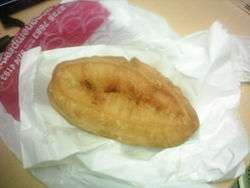Ox-tongue pastry
|
An Ox-tongue pastry that is available in congee restaurants in Hong Kong | |
| Alternative names | Horse-ear pastry |
|---|---|
| Type | Doughnut |
| Place of origin | Guangdong or Fujian, China |
| Main ingredients | fried dough |
|
| |
| Ox-tongue pastry | |||||||||||
| Chinese | 牛脷酥 | ||||||||||
|---|---|---|---|---|---|---|---|---|---|---|---|
| |||||||||||
Ox-tongue pastry (Chinese: 牛脷酥; Jyutping: ngau4 lei 6 sou1) or horse-ear pastry (Chinese: 马耳; pinyin: mǎěr) and may be referred to as a Chinese Doughnut is a Chinese cuisines that is popular in south China in the Canton or Fujian province. It is a fried dough food that is elliptical in shape and resembles an ox tongue or a horse ear. The pastry texture is chewy, with a soft interior and a crunchy crust. Ox-tongue pastry is lightly sweetened, and eaten as part of breakfast with soy milk. The pastry is made in a similar way as Youtiao, however, sugar is added to the flour.[1]
See also
- List of doughnut varieties
- List of fried dough varieties
- Shuangbaotai
- Youtiao
- Mandazi, a similar East African pastry
 Food portal
Food portal
References
- 曾大平, (2002), 民間小吃製作圖解 (Traditional snacks in China), 萬里機構 ISBN 962-14-2376-7
External links
 Media related to Ox-tongue pastry at Wikimedia Commons
Media related to Ox-tongue pastry at Wikimedia Commons
This article is issued from Wikipedia - version of the 10/4/2016. The text is available under the Creative Commons Attribution/Share Alike but additional terms may apply for the media files.
